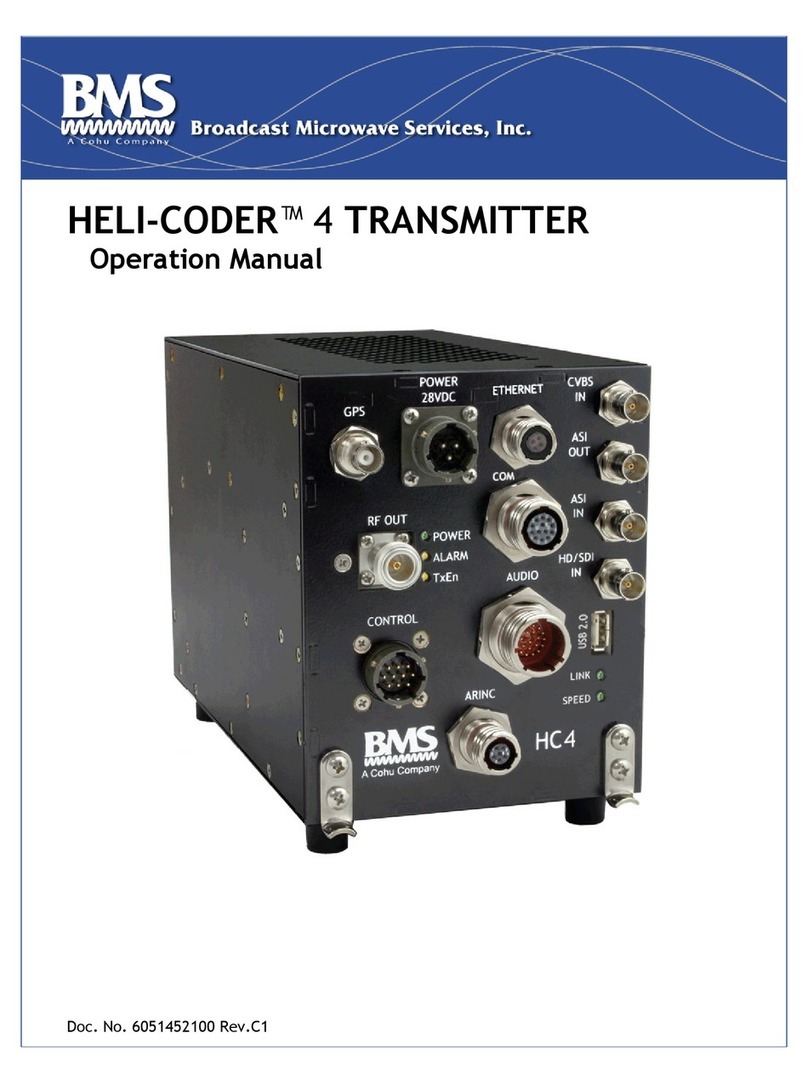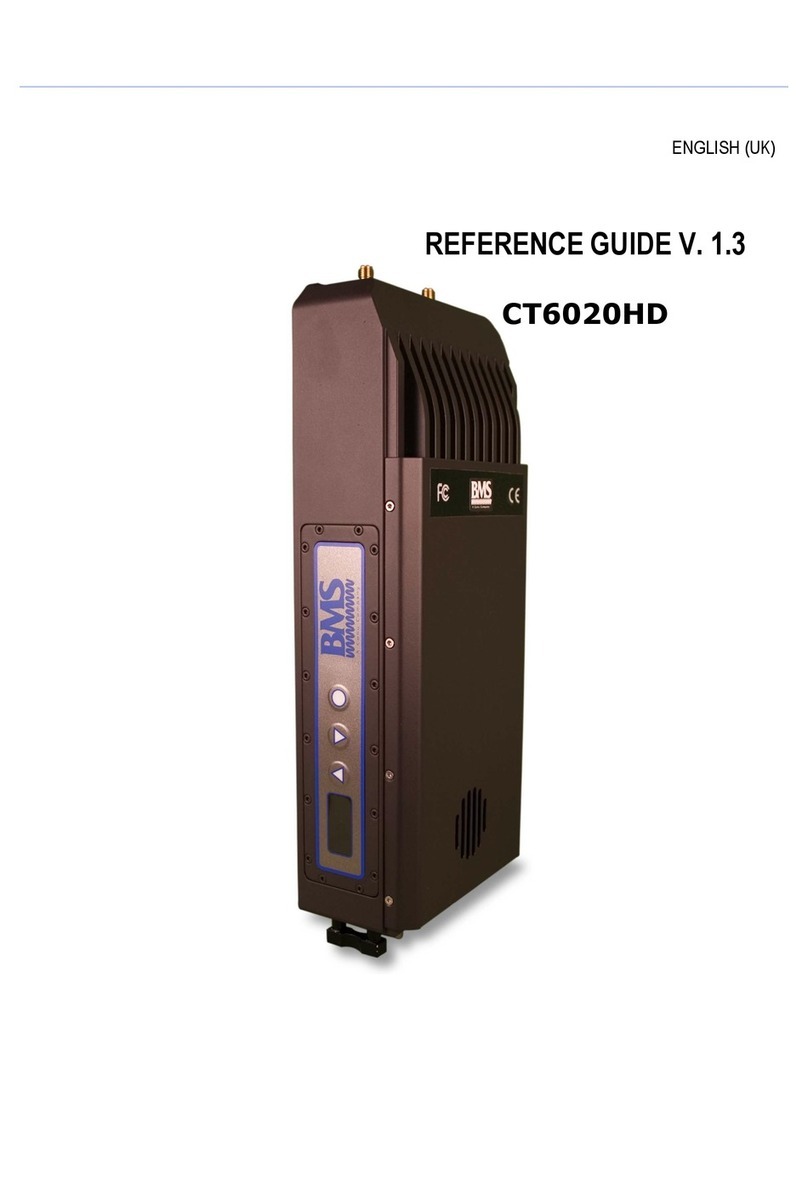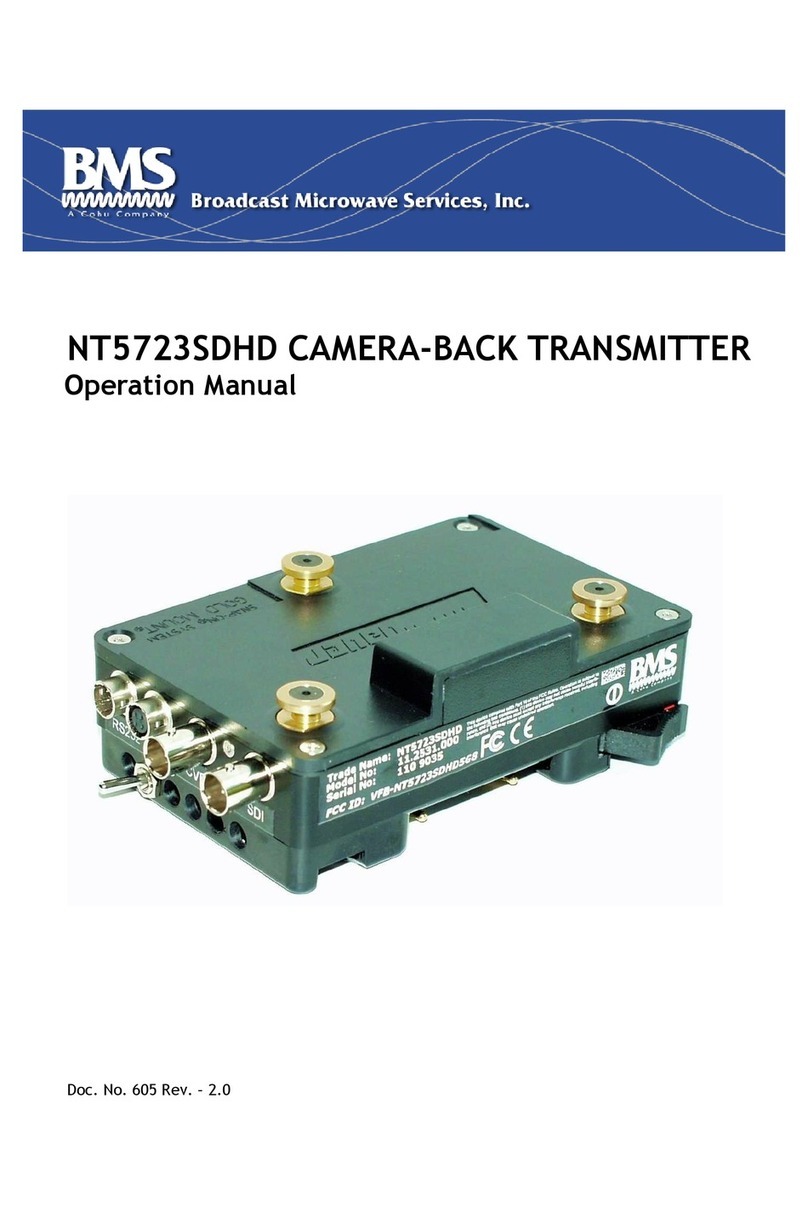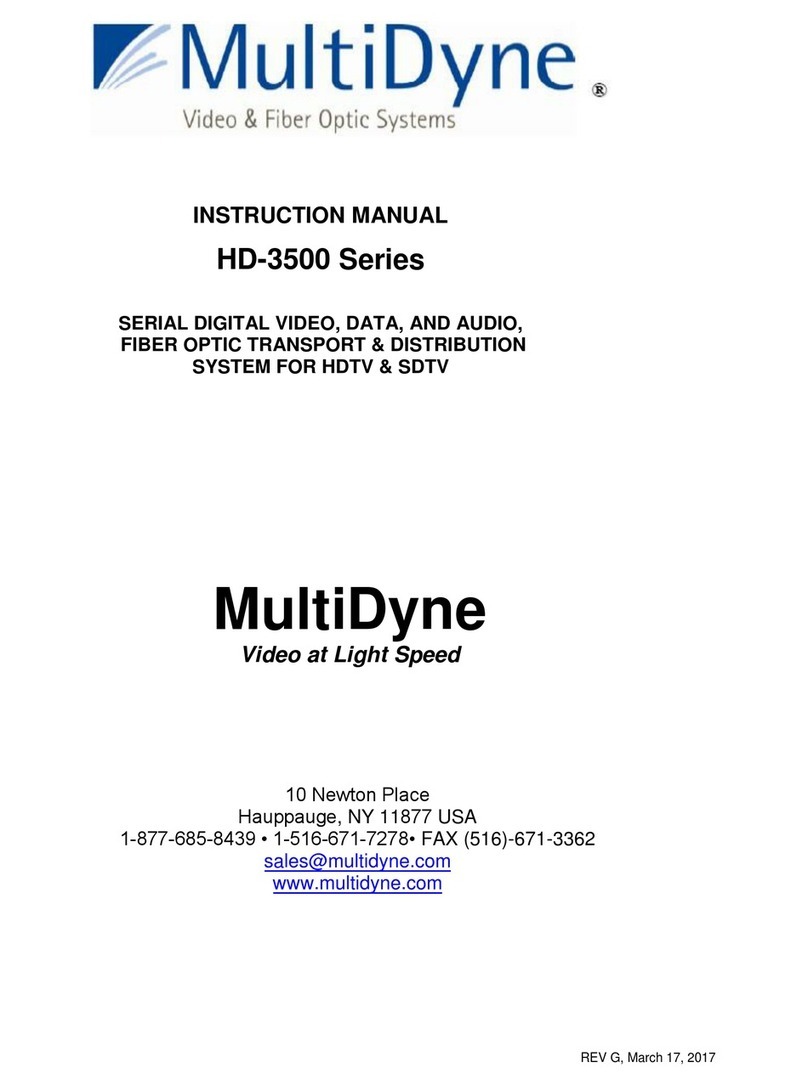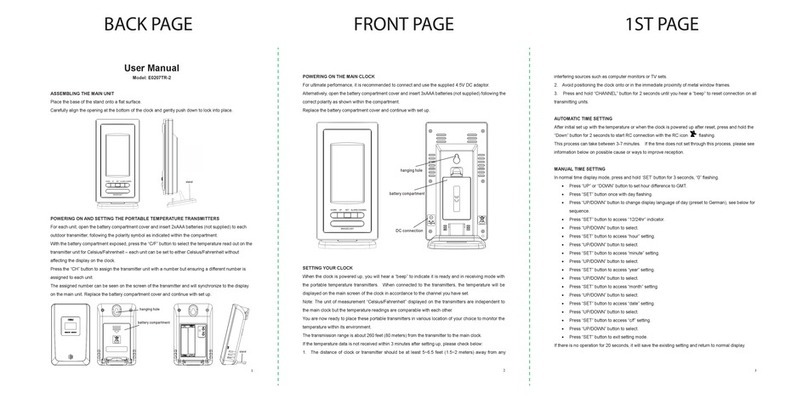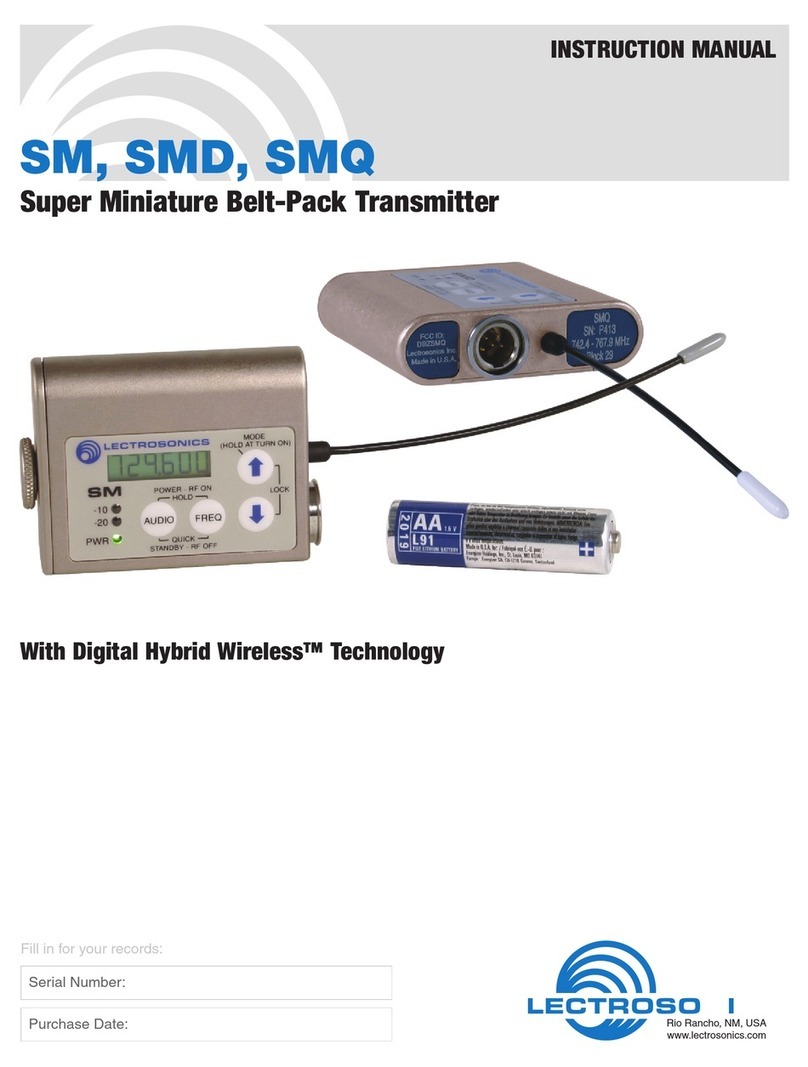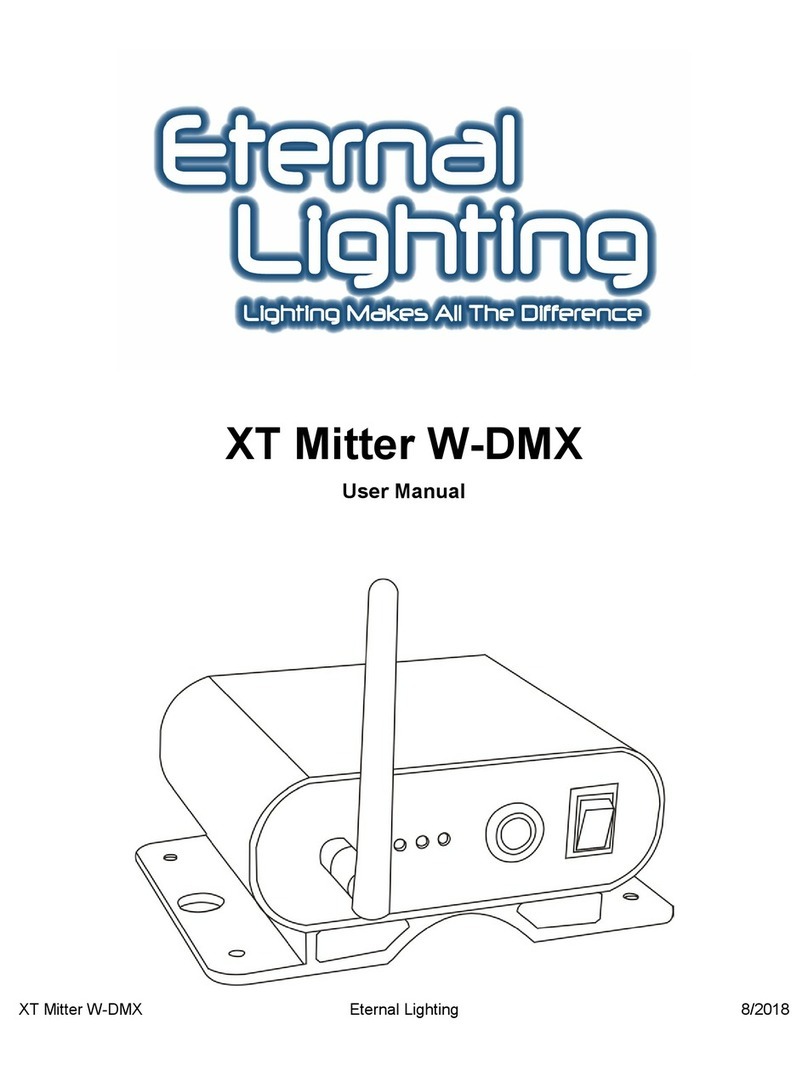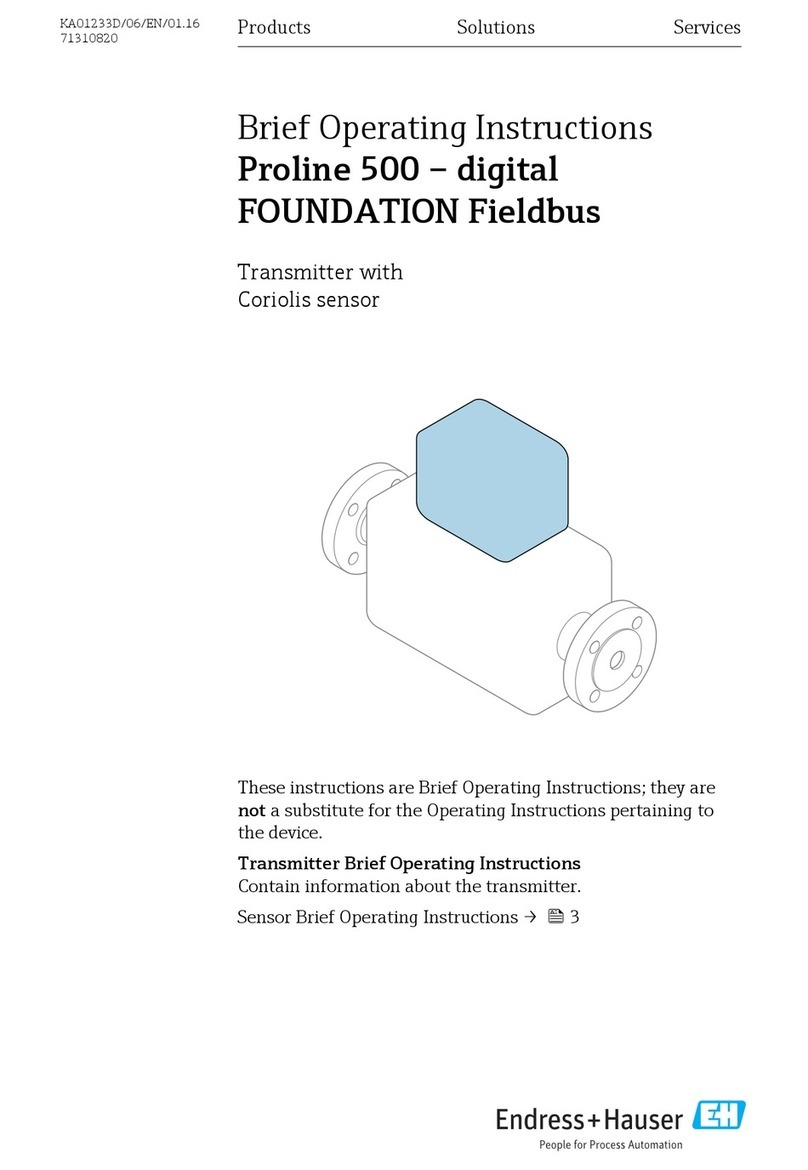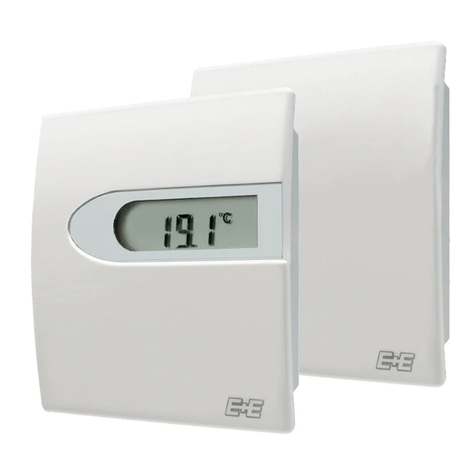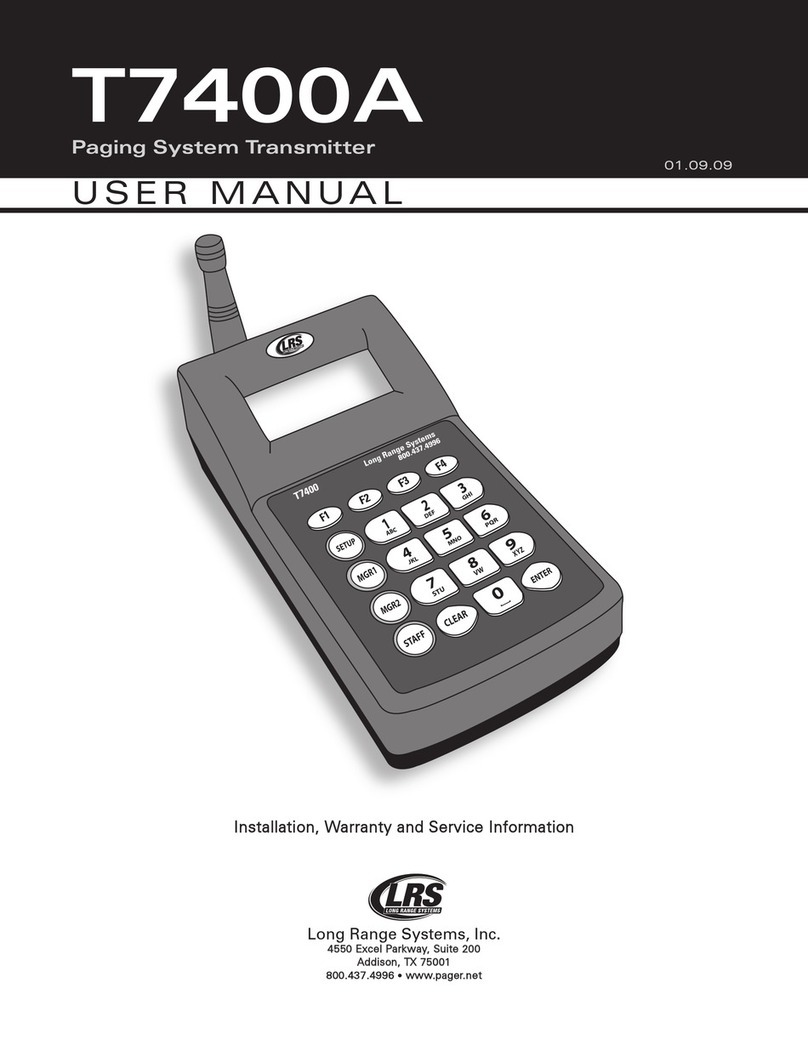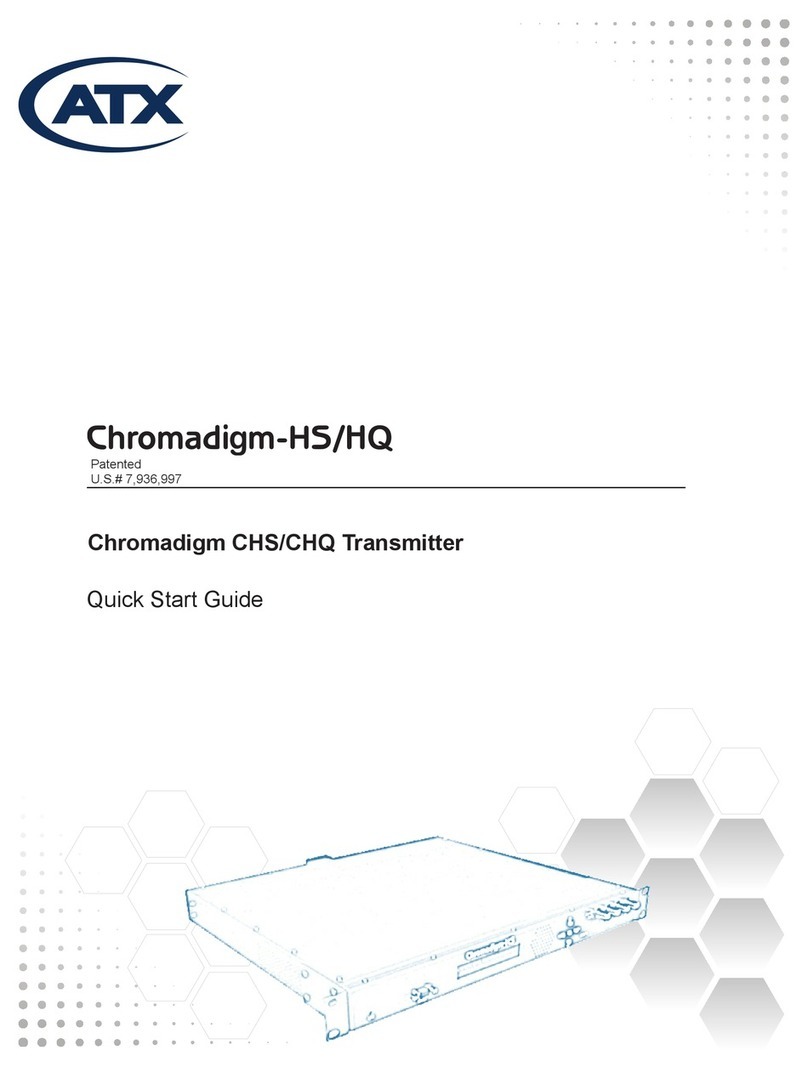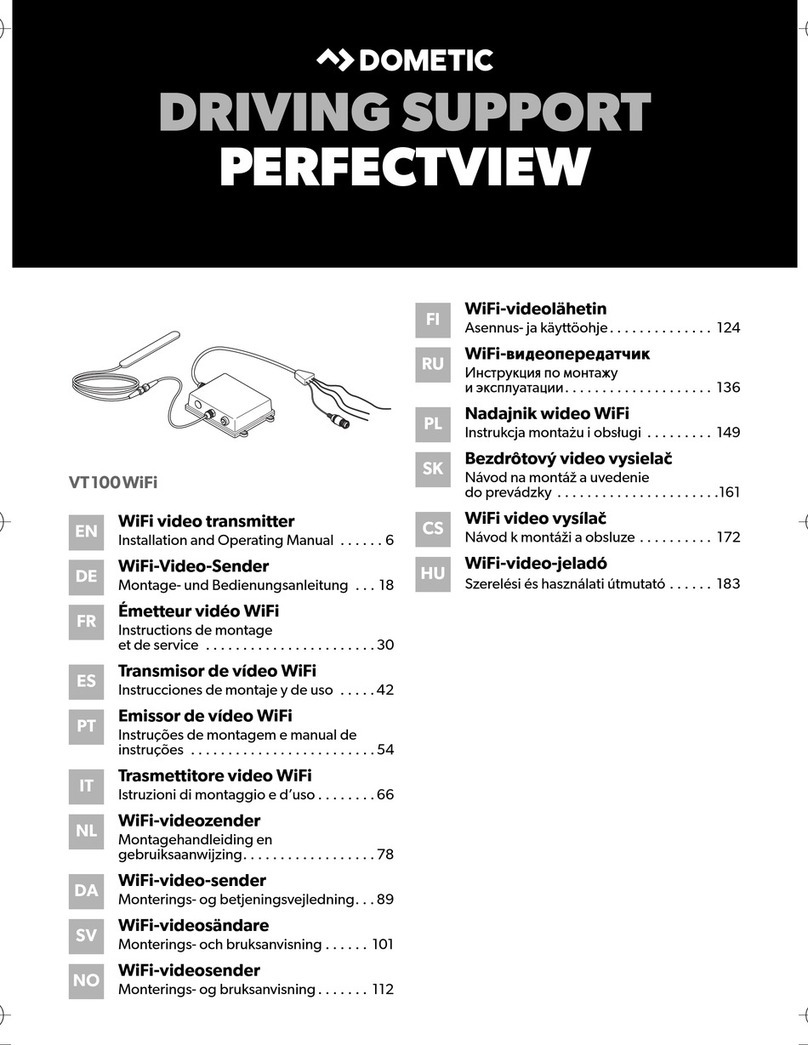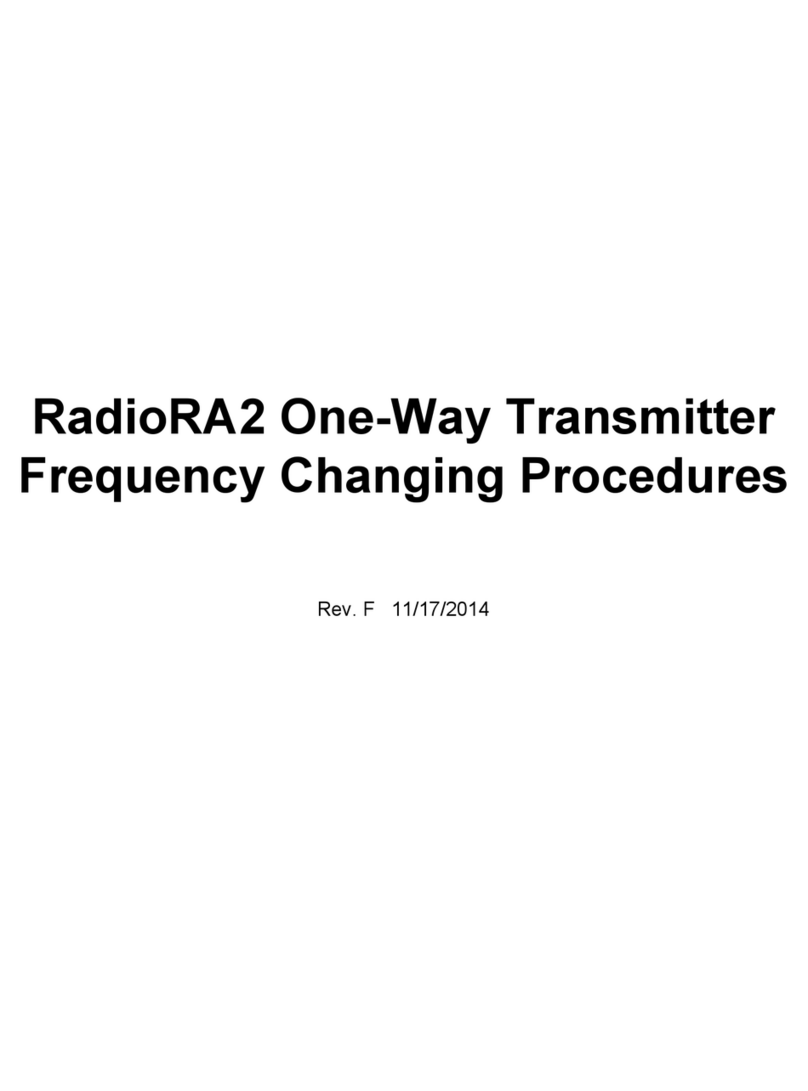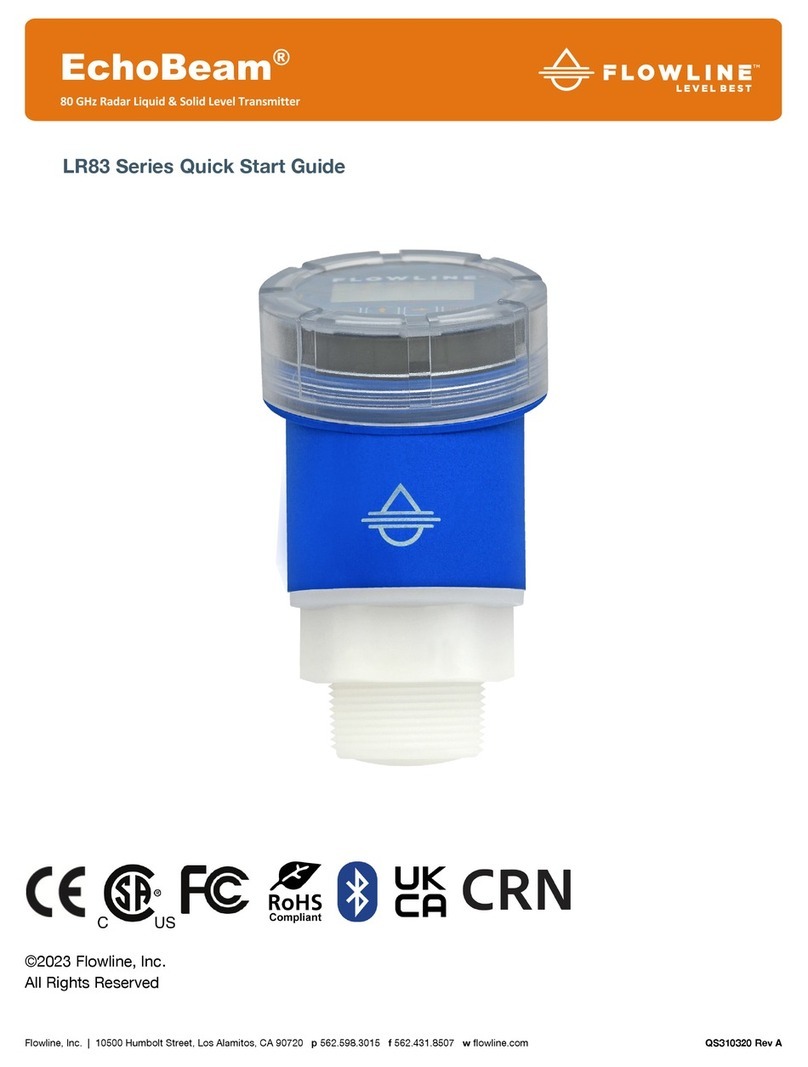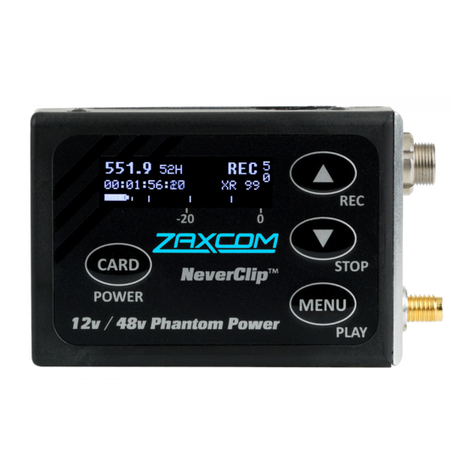BMS Truck-Coder II User manual

Installation and Operations Manual
7GHz Truck Coder II
System
DOC# 6051419100X3 July 2006
Broadcast Microwave Services, Inc.
12367 Crosthwaite Circle
Poway, CA 92064
800-669-9667, 858-391-3050
858-391-3049 FAX

This Page Intentionally Left Blank

INTRODUCTION
The BMS Truck-Coder II (TCII) is an ENG transmitter that operates in both digital (COFDM) and legacy
analog (FM) transmission modes. It features a DVB-T compliant (COFDM) modulator MPEG2 video
encoder. The system is designed to support both 12 MHz and 17 MHz BAS channel plans (in both Digital
and FM transmission modes). The two-unit system consists of an Indoor rack-mounted exciter Unit (IDU)
and an Outdoor mast-mounted RF Transmitter Unit (ODU). An optional second RF unit can be added to
support dual band operation. The system integrates support for mast mounted antenna relay, feed controls
and other accessories. The indoor unit provides support for multiple analog and video signal formats and
provides an industry standard 70MHz IF output.
The Truck-Coder II is designed to meet the rugged environmental needs of ENG news vehicles. It blends
our field proven technology with a rich feature set and the simple operation needed for ENG/OB
operations.
Applications:
•ENG News Vehicles
•Law Enforcement Command Posts
Key Features:
•Digital (COFDM) and Analog (FM) Transmission
•Ease of installation – a single coax cable interconnects the IDU and ODU
•Simple Set-up and Operation – menu driven user interface
•Up to 999 easily configurable user Presets (each capable of storing all system parameters)
•Front panel Ethernet Port simplifies firmware upgrades and supports web based management
•Fully configurable FM, COFDM and MPEG parameters (including PID’s) ensure product
compatibility
•Optional Dual Band Capability
This document provides instructions for the installation, operation and maintenance of the Truck Coder II
system.
Broadcast Microwave Services (BMS) is a leader in wireless digital microwave technology providing
innovative products for the television broadcast, video, telemetry and surveillance industries. A wholly
owned subsidiary of Cohu, Inc., BMS designs and manufactures a comprehensive line of microwave
communications equipment for broadcasting sports venues, law enforcement and military applications.
BMS also builds and integrates command and control centers to provide fully functioning, complex, end to
end digital systems.
For the latest product and system information please visit www.bms-inc.com.
Broadcast Microwave Services, Inc.
12367 Crosthwaite Circle
Poway, CA 92064
Tel: +1 (858) 391-3050
Toll free (US): 800-669-9667
Fax: +1 (858) 391-3049
Email:[email protected]
Web: www.bms-inc.com

ii
This Page Intentionally Left Blank

iii
Table of Contents
INTRODUCTION........................................................................................................................................... i
SYSTEM DESCRIPTION ............................................................................................................................. 1
Overview.................................................................................................................................................... 1
Indoor Unit................................................................................................................................................. 2
Outdoor Unit .............................................................................................................................................. 4
Technical Specifications ............................................................................................................................ 5
UNPACKING ................................................................................................................................................ 9
Parts List .................................................................................................................................................... 9
Manuals ................................................................................................................................................. 9
Components ........................................................................................................................................... 9
Cables .................................................................................................................................................... 9
INSTALLATION......................................................................................................................................... 11
Equipment Installation ............................................................................................................................. 11
Installing the Indoor Unit (IDU).......................................................................................................... 15
Indoor Unit (IDU) Connections........................................................................................................... 17
Installing the Outdoor Unit (ODU)...................................................................................................... 18
OPERATION ............................................................................................................................................... 22
Initialization ............................................................................................................................................. 22
WARRANTY............................................................................................................................................... 25
Customer Service Information ................................................................................................................. 25
TROUBLE SHOOTING .............................................................................................................................. 27
Diagnostics............................................................................................................................................... 28
PIN OUTS................................................................................................................................................ 30
IDU ...................................................................................................................................................... 30
ODU .................................................................................................................................................... 32
US Broadcast Frequency Assignments......................................................................................................... 34
Coded Orthogonal Frequency Division Multiplex (COFDM) Modulation .................................................. 36
Glossary........................................................................................................................................................ 40
List of Figures
Figure 1 TCII System Overview .................................................................................................................... 1
Figure 2 TCII IDU (Indoor Unit) Block Diagram .......................................................................................... 2
Figure 3 TCII Outdoor Unit (ODU) Block Diagram...................................................................................... 4

iv
Figure 4 IDU Footprint................................................................................................................................. 13
Figure 5 ODU Footprint ............................................................................................................................... 14
Figure 6 TCII Indoor Unit ............................................................................................................................ 15
Figure 7 TCII Indoor Unit Rear Panel Connections ..................................................................................... 17
Figure 8 TCII Outdoor Unit.......................................................................................................................... 18
Figure 9 ODU Mounting Footprint .............................................................................................................. 19
Figure 10 ODU Mounting Orientation ......................................................................................................... 20
Figure 11 ODU Connections ........................................................................................................................ 21
Figure 34 The HOME Menu ........................................................................................................................ 22
Figure 36 Product Label ............................................................................................................................... 25
Figure 37 IDU REAR PANEL CONNECTORS.......................................................................................... 30
Figure 38 ODU CONNECTORS ................................................................................................................. 32
List of Tables
Table 1 General Specifications....................................................................................................................... 5
Table 2 Analog (FM)...................................................................................................................................... 6
Table 3 Digital (COFDM) .............................................................................................................................. 6
Table 4 TCII Input/Output.............................................................................................................................. 7
Table 5 Component Mounting Requirement Reference ............................................................................... 11
Table 6 ODU Connections ........................................................................................................................... 21
Table 7 AUXILIARY INPUT PINOUTS .................................................................................................... 30
Table 8 SUMMARY ALARM PINOUTS ...................................................................................................30
Table 9 AUDIO 1 IN PINOUTS .................................................................................................................. 31
Table 10 AUDIO 2 IN PINOUTS ................................................................................................................ 31
Table 11 J1 EXTERNAL DATA IN ............................................................................................................ 32
Table 12 J2 EXTERNAL DC IN PIN OUTS (Optional) ............................................................................. 32
Table 13 J4 ANTENNA CONTROL PIN OUTS......................................................................................... 33
Table 14 ODU J5 EXTERNAL CONTROL PIN OUT................................................................................ 33

v
WARNING!
RF RADIATION EXPOSURE HAZARD
This warning is provided by Broadcast Microwave Services (BMS) Inc. for safety purpose. The
following information help to reduce the risk of RF exposure hazard.
FCC Limit of RF Exposure
According to Federal Communication Commission (FCC), the Maximum Permissible Exposure (MPE) for
FR radiation has been set to 1.0 mW/cm2for the 7GHz Truck-Coder II equipment (OET Bulletin 65).
The 7GHz Truck-Coder II is a non-broadcast transmitter and without an antenna it will not create RF
exposure (power density) exceeding the 1.0 W/cm2FCC limit.
However a high-gain antenna such as a parabolic dish will greatly enhance the Field-Coder II output power
density beyond the MPE limit of 1.0 mW/cm2.
In this situation a minimum distance from the antenna needs to be calculated in order to keep the MPE
always below the safety limit. The calculation has been done for Field-Coder II based on the formula
mentioned in OET Bulletin 56.
The calculations have been done for different commonly used antenna in Electronic New Gathering (ENG)
systems.
Transmission
Figure 1 shows the plot of the minimum exposure distance for 0dBi, 5dBi, 16dBi, and 30dBi antennas. The
7GHz Truck-Coder II transmits the maximum power of 4 Watts. The minimum exposure distances are
found from the cross points of the exposure graphs (for various antennas) with the line of maximum
permissible exposure (i.e. 1 W/cm2). Notice that the numbers in Figure 1 predict the worse case scenario,
which is straight in front of the antenna (exposing to the antenna main-lobe). Obviously the side-lobe
exposures are well below these numbers as the radiation intensity dramatically reduces on the side lobes.
The antenna used for this transmitter must not be co-located or operating in conjunction with any other
antenna or transmitter.
Antenna Specifications
The antenna for Truck-Coder II is customer's furnished equipment. The customer has a choice of using, for
instance, a 0dBi Omni antenna or a 30dBi dish antenna. The plots of Figure 1 provide the exposure distance
for 0dBi and 5dBi Omni antennas as well as 16dBi and 30dBi dish antennas.

vi
Estimated RF Exposure for 7 GHz Truck-Coder II
0.0
1.0
2.0
3.0
4.0
5.0
0 100 200 300 400 500 600 700
Distance , cm
Power Density, mW/cm^2
Max Permissible
Exposure: 1mW/cm2
30 dBi Antenna
Max Exposure at 560 cm
0 dBi Antenna
Max Exposure at 20 cm
16 dBi Antenna
Max Exposure at 112 cm
5 dBi Antenna
Max Exposure at 35 cm
Figure 1
Summary
In order the keep the RF exposure within the FCC limit, it is necessary to maintain the safe distance from
the antenna. The results shown in Figures 1 can be summarized in the following table:
Minimum permissible distance from antenna (cm)
Antenna Gain
(dBi)
0 20
5 35
16 112
30 560
Notice the above table indicates worst-case situation (straight in front of the antenna).

1
SYSTEM DESCRIPTION
Overview
The Truck-Coder II (TCII) is an ENG transmitter that will operate in both Digital (COFDM) and Analog
(FM) modes. The system comprises of an indoor unit (Exciter) and a mast mounted outdoor unit (RF
transmitter).
Figure 1 TCII System Overview
The indoor unit is designed to be rack mounted within an ENG van. It is housed in a 2RU 19-inch rack
mount enclosure and powered from a conventional 120V AC source. The indoor unit contains full featured
DVB-T compliant Digital (COFDM) and Analog (FM) exciters and associated power supplies. The IDU
provides the necessary DC voltage to power the ODU.

2
To simplify installation, only a single coaxial cable is required to interconnect the IDU to the ODU; DC
power, 70MHz IF and telemetry signals are all multiplexed onto this single cable. The system also supports
legacy cable systems that feed DC power on separate conductors.
The indoor unit features a menu driven front panel display (vacuum fluorescent) that is used to configure
the equipment and monitor its performance. The system is also designed to support remote control by 3rd
party equipment using either web based or simple RS232 protocol.
The outdoor RF unit (ODU) is designed to be mounted outdoors adjacent to the antenna. The ODU
translates the 70MHz IF signal from the IDU (exciter) to the desired operating frequency and amplifies the
signal to the desired level. The RF unit employs automatic level control circuits that keep the system
operating optimally and eliminate the need for any user adjustments.
The ODU uses a common signal path for both Analog (FM) and digital (COFDM) operation. Performance
is automatically optimized for both methods. BMS transmitters feature superior COFDM performance that
is adequate to support split channel operation in a 12MHz channel (see BMS white paper).
The ODU provides signals to control an antenna relay and feed polarity. Additional contact closures are
also provided for user specific applications.
A more detailed description follows:
Indoor Unit
A simplified block diagram of the IDU is shown below:
Figure 2 TCII IDU (Indoor Unit) Block Diagram

3
The FM modulator is designed to accept analog audio and video inputs. Support for 2 audio channels is
provided via frequency programmable sub carriers that ride above the video signal The frequency deviation
is user configurable to support operation in either a 17 MHz or 12 MHz channel allowing Analog operation
to continue after the channel plan transition is complete. Analog transmission offers a more graceful
degradation in performance and might be preferred under certain conditions.
The Digital (COFDM) modulator also supports 2 analog audio and one analog video input but also supports
advanced digital interfaces (ASI, SDI) as well. The digital modulator includes an MPEG2 encoder and a
DVB-T compliant COFDM modulator. Both MPEG and COFDM parameters are fully configurable by the
system controller in support of optimum performance and compatibility with other vendors equipment. For
those users less familiar with detailed COFDM and MPEG settings, the equipment provides 3 preset
robustness settings (low, mid and high) that each optimize video performance at the expense of modulation
complexity. High robustness provides the lowest quality video but is able to operate in severely
compromised locations. Low robustness provides the best quality video but may require a clear line of sight
shot.
An integrated SMPTE color bar generator with programmable text overlay is included. The indoor unit
features a menu driven VFD front panel display. Two levels of user access are supported; Operator and
Engineer. Operator is designed for non-technical users and assumes that the equipment has been
preconfigured by a station engineer. Engineer has full access to all menus and the ability to set up the
equipment for a less qualified operator.
The system accommodates up to 999 user programmable presets. These can be uniquely named and
configured; each preset records all of the configurable variables within the system. Presets 1 thru 6 are
conveniently displayed on their own screen for quick and easy recall. All presets can be uniquely named
via the front panel menu system to simplify identification and can be recalled quickly to put the equipment
in a known state. Presets are an ideal mechanism for the station engineer to pre-configure the equipment for
simplified operation by a less skilled operator.
The system also features a front and rear panel ethernet interface that can be conveniently used to upload
new operating firmware into the unit. This interface supports high data transfer rates and simplifies the
firmware upgrade process. This equipment makes extensive use of FPGA (field programmable gate array)
and microprocessor controlled hardware. Ease of firmware upgrade helps ensure that the equipment is
always kept up to date.
The TCII also includes embedded web based management that can be accessed with any PC using a web
browser and connected to the front or rear panel Ethernet port. This interface supports all the front panel
programmable features as well as others such as the ability to configure channel plans, and download
preconfigured presets (duplicate equipment setups). The system can be controlled remotely via an RS232
control port as well; consult BMS for the protocol specification for this port.

4
Outdoor Unit
A simplified block diagram of the ODU is shown below:
Figure 3 TCII Outdoor Unit (ODU) Block Diagram
The ODU is mounted outdoors and connected to the IDU by a single coaxial cable.
The ODU is in constant communication with the IDU via a telemetry channel that is frequency multiplexed
onto the single cable interface between the IDU and ODU. This channel is used to configure the ODU
(select frequency, power level etc) and also to monitor performance (PLL lock, temperature etc). A
microcontroller within the ODU handles this communication and controls the respective parts of the ODU.
The 70MHz input is first up-converted to the UHF band and then up-converted again to the desired
operating frequency. The signal is then amplified and fed to the antenna. A power detector at the
transmitter output helps ensure that the transmitter always operates most efficiently which is particularly
important when transmitting digital COFDM.
The ODU provides connector interfaces to support remote (mast mounted) antenna selection and antenna
feed polarity selection. Four additional contact closures are also provided for user specific applications.
These are controlled by corresponding inputs at the IDU.
A temperature sensor is included in the ODU and can be monitored on the IDU front panel. If the
equipment is operated in extremely hot temperatures the ODU will automatically back off the output power
to preserve operation and prevent damage to the unit.

5
Technical Specifications
Table 1 General Specifications
Indoor Unit (IDU) Outdoor Unit (ODU)
Size 17.5 x 14.9 x 3.5 in
(44.1 x 37.8 x 8.9 cm)
15.0 x 3.7 x 9.0 in
(38.1 x 22.9 x 9.2 cm)
Weight 11 lb (5 kg) 16.5 lb (7.5 kg)
Oper Altitude 15,000 ft 15,000 ft
Operating Temp -20 - +55º C -20 - +55º C
Stor. Temp -30 - +70º C -40 - +80º C
Relative Humidity 98% NC 100%
Power Req 105-260 VAC 50/60 Hz 48 VDC (supplied by IDU)
Ventilation Requirements Fan inlet and outlets must have no
obstruction
Fins must be oriented vertically on
antenna mast
Specification
Frequency 6.4 – 7.2 GHz
(Pre-programmed with US 12 MHz and 17MHz BAS channel plans
including offsets)
Tuning Step Size 250KHz
Frequency Stability +/- 5ppm max
Power Consumption 200W max
Recommended IDU-ODU Cable 100ft max
50 or 75 Ωcable (selectable)
Average Output Power
(6.4 – 7.2 GHz) FM COFDM
4 W (typical) 4 W (typical)

6
Table 2 Analog (FM)
Feature Spec
Video
Video Deviation (MHz) 4.0MHz pk /17 MHz Ch
3.5MHz pk /12 MHz Ch
Video Pre-Emphasis 405
(Per CCIR Recommendation)
VSNR (@12 MHz) 2 GHz 63 dB Typical (60 dB min.)
7 GHz 63 dB Typical (61 dB min)
Audio
Audio Sub-Carriers (2) Frequency (Programmable)
#1 4.83, 5.5, 5.8, 6.2, 6.8 MHz
#2 5.5, 5.8, 6.2, 6.8, 7.5 MHz
Audio Deviation ± 75kHz pk
Audio Pre-Emphasis 75 µS
Audio Distortion 1% max
Table 3 Digital (COFDM)
Feature Spec
Bandwidth 6, 7, 8 MHz Selectable
Constellation QPSK, 16 QAM, 64 QAM, Selectable
Guard 1/4, 1/8, 1/16, 1/32 Selectable
Code Rate 1/2, 2/3, 3/4, 5/6, 7/8 Selectable
Scrambler Proprietary 6 digit PIN code
MPEG – 2 4:2:0 SP@ML 1.5 – 15 Mb/s, 0.1 Mb/s Resolution
MPEG – 2 4:2:2 SP@ML 1.5 – 32 Mb/s, 0.1 Mb/s Resolution
GOP Structure I/IP/IBBP/422IBBP Variable
GOP Length 6/12/18/24 Selectable
Audio Sampling Rates 32, 64, 128, or 192 kb/s per Channel
Audio, Video, PCR PID User programmable

7
Table 4 TCII Input/Output
I/O Format
IF OUT (to ODU) 70 MHz IF Output with Control & Power
(selectable 50 or 75 ohms)
IF IN 70 MHz (0dBm, 75 Ω)
Aux. IF OUT 70 MHz (0dBm, 75 Ω, BNC-f)
ASI IN 75 Ω(HD Capable)
ASI OUT Encoder Output 75 Ω(BNC-f)
Digital Video IN SDI w/Embedded Audio
(SMPTE 259C CCIR 601)
Aux Inputs (4) General purpose inputs that control respective Form
‘C’ contact closures available at the ODU.
Summary Alarm Form ‘C’ Contact Closure (Rated 1A Max )
External Control 1
(Remote Control Of TCII)
Ethernet 10/100 bT
Digital (COFDM) Analog (FM)
Audio Inputs (2)
Impedance 600 ohm Bal
Level +0 dB nom
menu adj atten +4 to -9dB,
in 1dB steps
+9dBm
(Factory Set)
Composite Video Input
Level 1V p-p
Return loss 26dB min
Impedance 75 ohms unbal
YUV Video Input (Optional) Optional Not Available
RS232 (general purpose data channel to CRS-
DCII)
User selectable
1200, 4800, 9600 baud
Not operational
1Consult Factory For Protocols

8
This Page Intentionally Left Blank

9
UNPACKING
No special instruction is required for removing the items from the packaging other than to open the box
with care as to not damage any of the contents.
Parts List
Manuals
Item Part Number Quantity
TRUCK-CODER II INSTALLATION AND
OPERATION MANUAL
6051419100 1
Components
Item Part Number Quantity
Indoor Unit (IDU) 8014191000 1
Outdoor Unit (ODU) 8014192700 1
Installation Kit 7614191020 1
Cables
The versatile design of the TCII makes it suitable for many different applications. Depending on the needs
of the ENG, there is a great variety of cable configurations. The table below provides a list of all the cables
that the TCII can accommodate and along with the BMS part numbers. The specific cable set for any
application is defined when an order is placed. Please refer to the packing list and/or the original sale order
for the specific cables included with your TCII System.
Cable Recommended
Cable
P/N
Length End
Connector
P/N
70 MHz/ 48 VDC (to ODU) TIMES SF-214
(STANDARD)
100 ft ( 30.5 m) 210009800
70 MHz/ 48 VDC triax (to
ODU) Belden 8232 100 ft ( 30.5 m) 210071813
70 MHz IN 100 ft ( 30.5 m)
70 MHz OUT 100 ft ( 30.5 m)
SDI IN w/ AUDIO 100 ft ( 30.5 m)
ASI IN 100 ft ( 30.5 m)
ASI OUT 100 ft ( 30.5 m)
VIDEO IN 100 ft ( 30.5 m)
VIDEO OUT 100 ft ( 30.5 m)
Y,U, V input
600001300
100 ft ( 30.5 m)
210015200
AUDIO 1 IN 100 ft ( 30.5 m)
AUDIO 2 IN 600000100 100 ft ( 30.5 m) 210019300
RS-232 DCE 100 ft ( 30.5 m)
RS-232 CONTROL 100 ft ( 30.5 m)
RS-232 AUX DATA
Custom
100 ft ( 30.5 m)
210022000

10
This Page Intentionally Left Blank

11
INSTALLATION
NOTE:
The TCII equipment installation should only be performed by qualified technicians in compliance with
safety regulations and accepted industry practices.
Equipment Installation
The following equipment will need to be installed:
Indoor Unit (IDU)
Outdoor Unit (ODU)
Please refer to component footprint drawings listed in Table 5 to aid installation.
Table 5 Component Mounting Requirement Reference
Component Footprint
Indoor Unit (IDU) Figure 4
Outdoor Unit (ODU) Figure 5

12
This Page Intentionally Left Blank
Table of contents
Other BMS Transmitter manuals
